High Street in 1839
High Street in 1839
The earliest image?
The hand-tinted stone lithograph, entitled 'Market Place - Yeovil' illustrated below, was by Henry Burn (1807-1884) who left for Australia in 1852. When compared with later photographs, Burn's lithograph is remarkably accurate. It was published by William Porter and Henry Marsh Custard in January 1839 and printed by Charles Joseph Hullmandel (1789-1850) of London, where he maintained a lithographic establishment on Great Marlborough Street from about 1819 until his death. This is a very early lithograph for Burn, as almost all of his other known works date from the 1840s onwards.
Another lithograph of Yeovil by Burn, also dating to 1839, is entitled 'View of Yeovil from Babylon Hill' (see bottom of this page).
The lithograph looks down High Street from its junction with Hendford / Princes Street. On the left, the first building stands on the corner of High Street and Princes Street. Next, the Mermaid with its familiar archway and large overhanging sign is clearly seen. On the opposite side of the road, just right of centre, the white three storey building with the two-storey projecting bay is the Kings Head Inn. It is likely that the two storey building between the tree and the Kings Head Inn is the building that held the former George Inn. To the right of the King's Head In is George Glyde's china and glassware shop, then the chemist and druggist premises of Edward Granger. Finally is just seen a small portion of 25 High Street - most recently Beale's store, but in 1839 it was the premises of drapers Edwards and Dean.
The Gallery below shows the whole image, followed by enlargements of individual buildings.
gallery

From my
collection
The entire image of the hand-tinted stone lithograph, published in January 1839.

From my
collection
This building, with its fine Venetian window and decorative cornice at roof level, stood on the corner of High Street and Princes Street until it was replaced in 1897 by the three storey Capital and Counties Bank. It is not possible to tell from the early census records who occupied this building in 1839 and there was certainly no-one with a surname ending in 'ORY' as seen on the sign above the Princes Street window. During the 1890s, in the period immediately prior to its demolition, it had been the shop, workshop and living accommodation of upholsterer, cabinetmaker and furniture dealer Henry White.

From my
collection
The well-known elevation of the Mermaid Inn. That part to the left of the ogee-arched entrance was originally a private house but had been incorporated into the Mermaid Inn by this time. The licensee of the Mermaid during this period was Edward Mines.

From my
collection
The building in the background at centre of the lithograph, between the Mermaid's sign and the covered waggon, is something of a mystery.
 I
thought at first
that this
building was
Under Bow on
the corner of
Wine Street,
however if
you stand
outside the
Mermaid today,
as this photo at
left,
and look towards
the Borough the
only building
you can see is
Burger King. I
therefore had
two lines of
thought.
I
thought at first
that this
building was
Under Bow on
the corner of
Wine Street,
however if
you stand
outside the
Mermaid today,
as this photo at
left,
and look towards
the Borough the
only building
you can see is
Burger King. I
therefore had
two lines of
thought.
My first thought was that this was a building that pre-dated the Medical Hall (built in 1860) on the corner of Middle Street. However, consulting early maps it becomes clear that what would have been visible in 1839 would be the Market House that stood in the Borough - in front of the Medical Hall. The problem is that it apparently looked nothing like the building in the lithograph - more than one contemporary image shows the Market House as a roof supported by spaced-out timber posts, giving it a very open look (from the ends as well as the sides) unlike what appears to be a solid building with a tall archway, as in the lithograph.
I think this will remain a mystery for now - unless you know differently.
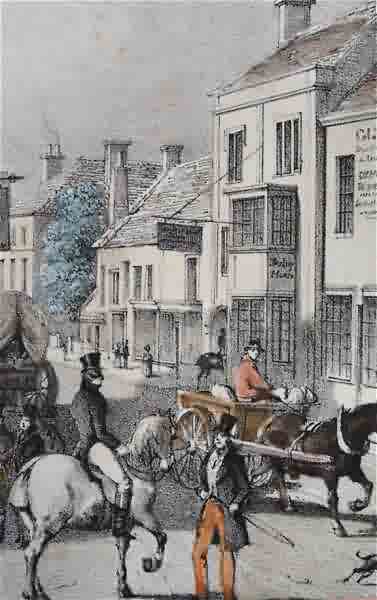
From my
collection. This
lithograph
features in my
book "Lost Yeovil"
It is probable that the building to the right of the tree was the former George Inn (or at least, the site of it). However the last record of the George Inn was in 1770 and certainly by 1820 the inn formerly known as the Three Cups in Middle Street was known as the George; therefore this may be the same building, or it may have been rebuilt - although the first floor fenestration certainly does not match later photographs. Around the time of this image, or very shortly thereafter, the building became the ironmongery of James Corfield.
The large three-storey building with the two-storey projecting bay and a hanging sign was the King's Head Inn and this is the only image of the King's Head I know of. Known before the mid-17th century as the Cock in the Hoop, in 1839 the licensee of the King’s Head Inn was John Melmoth. The writing on the side of the two-storey projecting bay reads 'Posting House'.
Look carefully and you will notice a horse being ridden into the arch of the King's Head Inn to the left of the projecting bay windows. This was not the entrance to George Court, which was to its immediate left, but gave access to the King's Head's stabling at the rear.
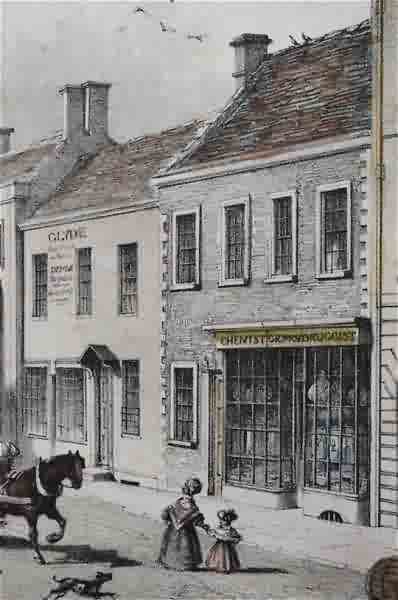
From my
collection
At left is the china and glassware establishment of George Glyde. At least from 1829, George clearly rented the premises and the owner put the property up for sale in 1829 giving a good description "Dwelling-House, commodious Front Shop, Store-rooms, and Offices attached, with a good garden, two comfortable Cottages, Stable, and Gig-house in South Street". Glyde remained in the building until 1846, when he was succeeded by Mr H Raymond. At the time of the lithograph this building was less than fifty years old, its predecessor being described by Daniel Vickery as "a low pent house, with a thatched roof".
The building at right, a property belonging to the Corporation, was the chemist and druggist premises of Edward Granger and the large glass vessels that were the distinctive sign of his trade are clearly seen in the shop windows. Both before and after this lithograph, this building was the Fleur-de-Lys, today it survives (albeit altered) as part of what was Beales' store. Granger rented the building from 1834 until he retired around 1850.
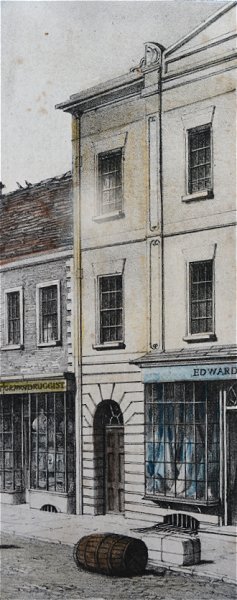
From my
collection
At extreme right of the lithograph are just two bays of the new (built 1836) shop premises of Edwards & Dean - later Lindsay Denner's and today's Beales' store.
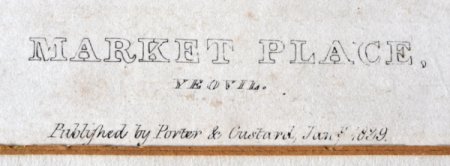
From my
collection
The title of the lithograph.

.... and the credits.
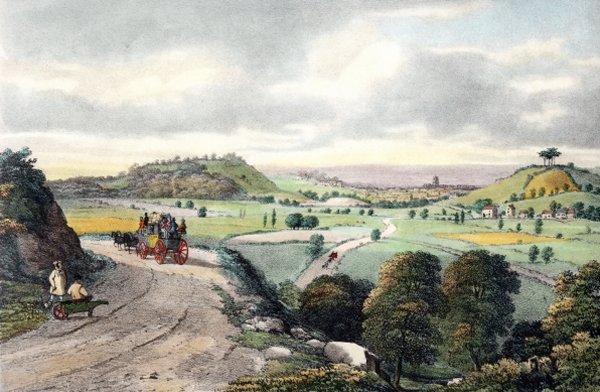
From my
collection
'View of Yeovil from Babylon Hill' - the other known stone lithograph of Yeovil by Henry Burn, and again published by Porter & Custard in January 1839.